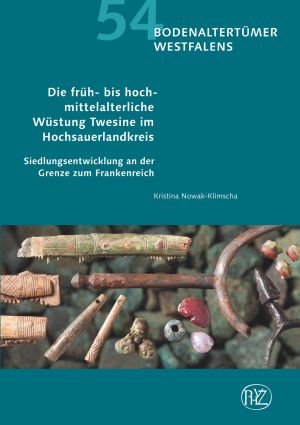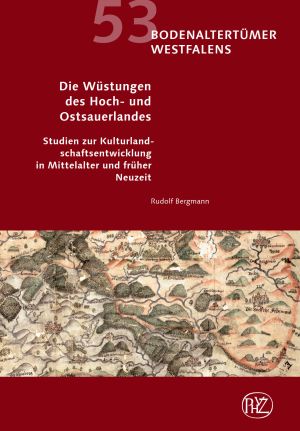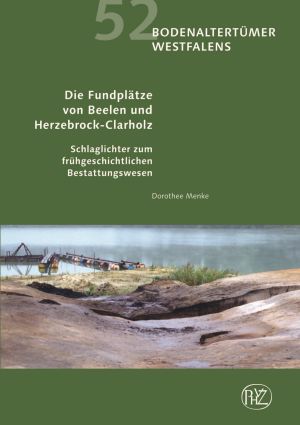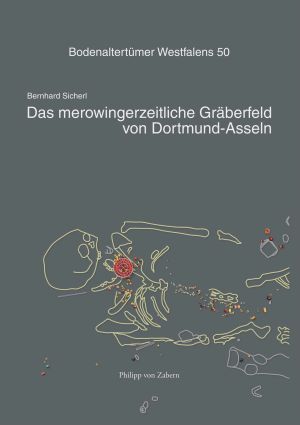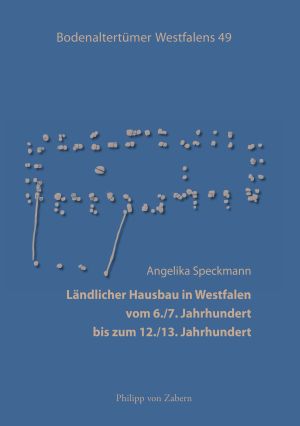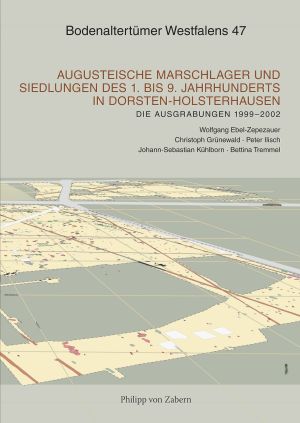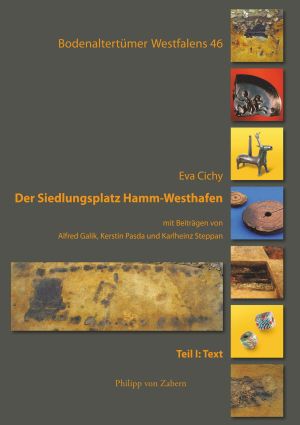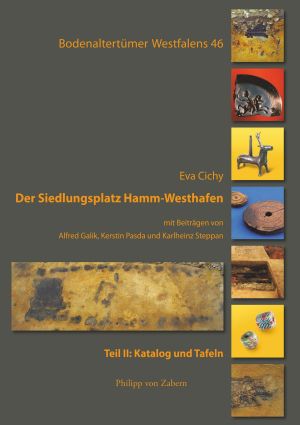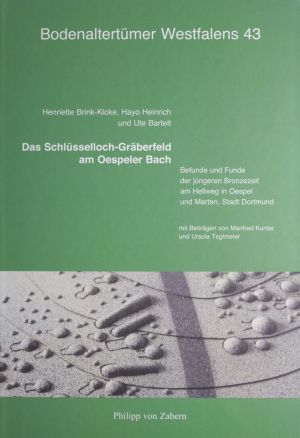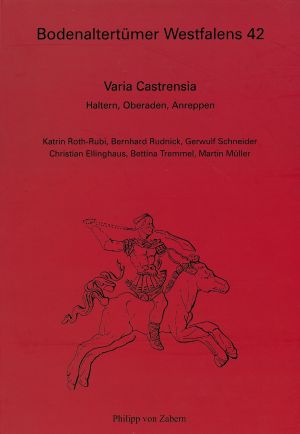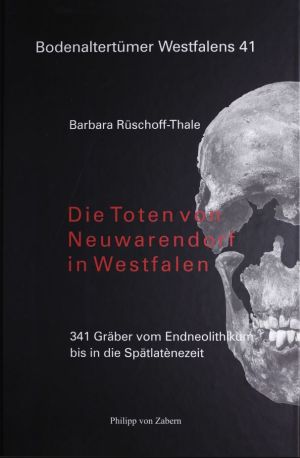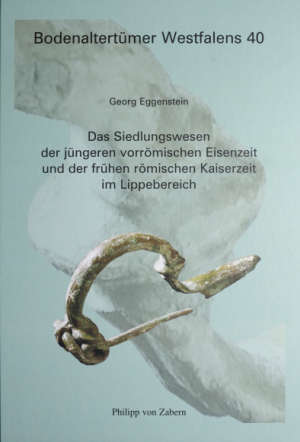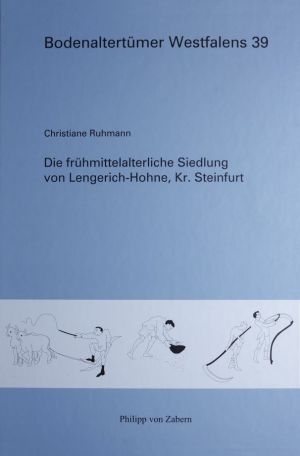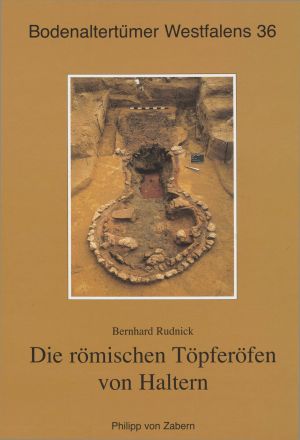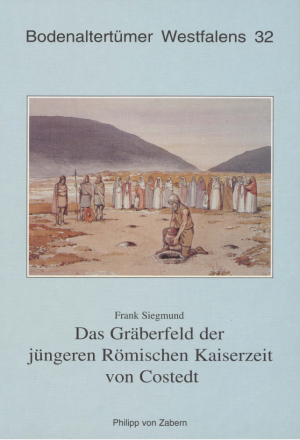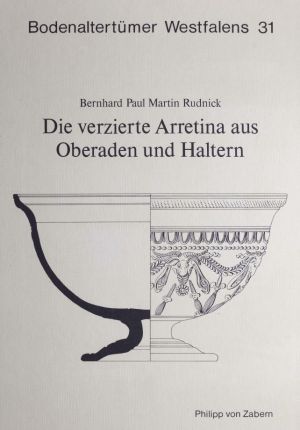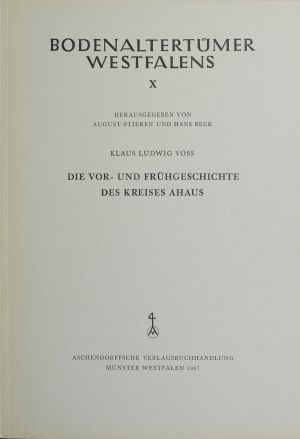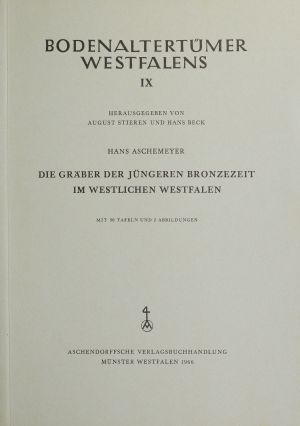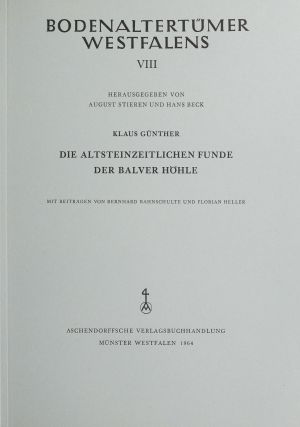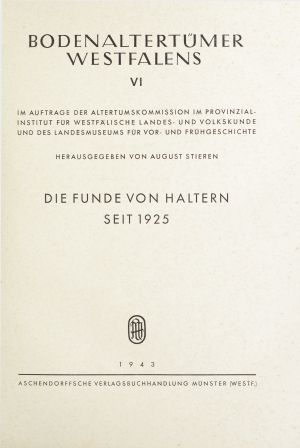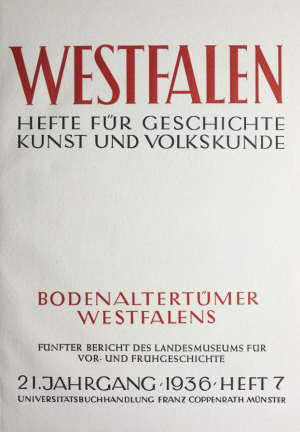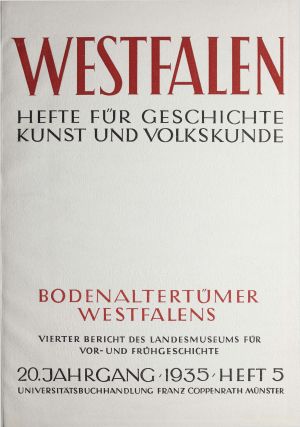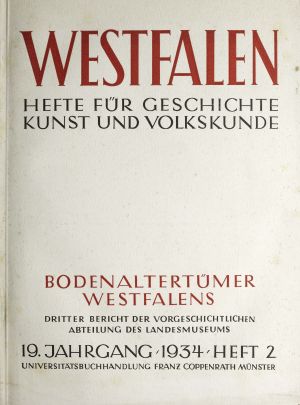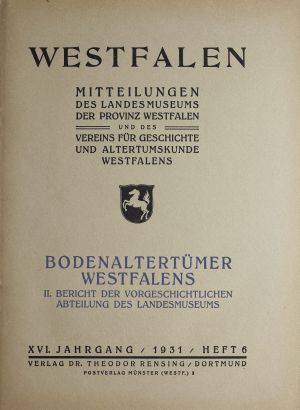Bodenaltertümer Westfalens
„Bodenaltertümer Westfalens“ (BAW) ist die Reihe der LWL-Archäologie für Westfalen mit der längsten Tradition: Der erste Band wurde bereits 1929 veröffentlicht. Die ersten Ausgaben erschienen in gemeinsamer Herausgeberschaft mit der Altertumskommission für Westfalen in der Zeitschrift „Westfalen. Hefte für Geschichte, Kunst und Volkskunde“. Seit Band 6 aus dem Jahr 1943 ist BAW eine eigenständige Reihe.
In Form von Monografien oder Aufsatzsammlungen werden hier Forschungsergebnisse aus der westfälischen Bodendenkmalpflege publiziert – zu einzelnen Ausgrabungen ebenso wie zu übergreifenden Fragestellungen. Die zeitliche Spanne reicht dabei vom Paläolithikum bis ins Frühmittelalter. Autoren sind die Wissenschaftler unseres Hauses, der westfälischen Stadtarchäologien, Universitäten und Grabungsfirmen.
Die Reihe erscheint unregelmäßig und wird als Printversion in Kommission vom Verlag Philipp von Zabern (WBG) vertrieben. Restbestände von einigen Bänden sind online erhältlich über den Verlag Beier & Beran.
Zukünftig sollen die Bände mit Erscheinen der Printausgabe auch hier im Open Access zur Verfügung gestellt werden. Parallel werden die älteren Bände digitalisiert und nach Einholung der Nutzungsrechte ebenfalls nach und nach online bereitgestellt.
![]()
Herausgeber
LWL-Archäologie für Westfalen
An den Speichern 7
48157 Münster
E-Mail: lwl-archaeologie@lwl.org
Internet: www.lwl-archaeologie.de
Bisher erschienen
Die früh- bis hochmittelalterliche Wüstung Twesine im Hochsauerlandkreis: Siedlungsentwicklung an der Grenze zum Frankenreich
Am Fuße des Bergplateaus der Eresburg – dem heutigen Obermarsberg – befindet sich die früh- bis hochmittelalterliche Wüstung Twesine. Für die Geschichte Westfalens hat diese Siedlung eine besondere Bedeutung, da hier frühe Relikte der Kupferverhüttung entdeckt wurden. Die Abfallprodukte der Kupfer- und Eisengewinnung finden sich in Twesine in einer bis zu 60 cm hohen und 3000 m2 großen Halde. Sie zeugen von allen Stufen der Metallverarbeitung, für die die Lagerstätten am Obermarsberg ausgebeutet wurden. Kristina Nowak-Klimscha geht der Frage nach, ob die Siedlung mit den hier vorhandenen metallurgischen Kenntnissen zusammen mit der Eresburg zum Spielball der macht- und wirtschaftspolitischen Interessen Karls des Großen in den Sachsenkriegen wurde.
Die vorliegende Arbeit wurde 2014 an der Ruhr-Universität Bochum als Dissertation angenommen.
Die Wüstungen des Hoch- und Ostsauerlandes: Studien zur Kulturlandschaftsentwicklung in Mittelalter und früher Neuzeit
Ortswüstungen – also im Mittelalter verlassene ländliche Siedlungen – stellen einen wichtigen, aber oftmals wenig beachteten Faktor für die Entwicklung der heutigen Kulturlandschaft dar. Diesen Wüstungen ist das von dem europäischen Förderprogramm LEADER unterstützte Projekt des Autors Rudolf Bergmann gewidmet. Erstmals werden dabei alle Hinweise zu den aufgelassenen Orten des Mittelalters für das Gebiet des modernen Hoch- und Ostsauerlandes um die sechs Städte Brilon, Hallenberg, Medebach, Marsberg, Olsberg und Winterberg in einem Band zusammengeführt.
Den Hauptteil der Arbeit bildet der annähernd 400 Seiten starke Wüstungskatalog. Dort sind für jede ehemalige Siedlung ausführlich historische Textbelege, kartografische Informationen, geografische Besonderheiten und archäologische Funde wiedergegeben.
Die Daten belegen eindrucksvoll, dass das Hochsauerland bereits im frühen Mittelalter weitgehend von Siedlern erschlossen war und erst zu Beginn der frühen Neuzeit durch eine Vielzahl von Faktoren großflächig entvölkert wurde.
Die Fundplätze von Beelen und Herzebrock-Clarholz: Schlaglichter zum frühgeschichtlichen Bestattungswesen
Der völkerwanderungszeitliche Scheiterhaufenplatz in Herzebrock-Clarholz ist auch überregional eine echte archäologische Rarität. Außerdem wurden hier 22 Gräber aus dem 4. und 5. Jahrhundert untersucht. Für die Hinterbliebenen war anscheinend die Bestattungszeremonie selbst von zentraler Bedeutung, denn ein erheblicher Teil der Beigaben und der Knochen verblieb am Ort der Verbrennung und gelangte nicht in die Gräber. Diese Erkenntnis hat entscheidende Auswirkungen auf die Rekonstruktionen der damaligen Gesellschaften, die sich häufig auf Grabbeigaben stützen.
Die lange Belegung des Gräberfeldes in Beelen vom 3. bis zum 7. Jahrhundert deutet eine Siedlungskontinuität über das Ende der römischen Kaiserzeit hinaus an. In Beelen und Herzebrock-Clarholz zeigt sich eine Bevölkerung, die sich mal mehr an fränkischen, mal mehr an sächsischen Vorbildern orientierte. Auch hier finden sich keine Belege für die inzwischen überholte These der gewaltsamen Südausbreitung der Sachsen und der Einbeziehung Westfalens in den sächsischen Machtbereich seit dem Ende des 7. Jahrhunderts.
Diese Arbeit wurde 2008 von der Westfälischen Wilhelms-Universität Münster als Dissertation angenommen.
Das merowingerzeitliche Gräberfeld von Dortmund-Asseln
Frühmittelalterliche Gräberfelder sind in Westfalen selten, erst recht im Ruhrgebiet. Daher war es besonders erfreulich, dass in Dortmund-Asseln bei einer systematischen Ausgrabung vierzehn weibliche und zehn männlichen Individuen in überwiegend unberaubten, für westfälische Verhältnisse gut erhaltenen und bestens ausgestatteten Körpergräbern untersucht werden konnten. Zudem kamen ein Pferdegrab und ein Hundegrab zutage. Der Ausgräber Bernhard Sicherl erreichte trotz schwierigster Bodenverhältnisse ein Maximum an Befundinformationen, sodass zusammen mit dem reichhaltigen Fundmaterial eine hervorragende Grundlage für die Auswertung der Gräber vorhanden ist. Der Wert des Gräberfeldes von Dortmund-Asseln liegt vor allem darin, dass hier in einem überschaubaren Rahmen Modelle für denkbare Sozialstrukturen erarbeitet werden konnten, die möglicherweise auch andernorts zum Verständnis merowingerzeitlicher Lebensformen beitragen.
Ländlicher Hausbau in Westfalen vom 6./7. Jahrhundert bis zum 12./13. Jahrhundert
Nicht nur in Westfalen stellt die wissenschaftliche Bearbeitung ländlicher Baubefunde des Mittelalters ein Desiderat der archäologischen und bauhistorischen Forschung dar. Es handelt sich fast ausschließlich um Bauten aus Holz, die heute vergangen und daher ungleich schwieriger zu erforschen sind als die erhaltenen monumentalen Zeugen mittelalterlicher Architektur aus Stein.
Angelika Speckmann hat die Forschungslücke nun geschlossen und für diese aktuelle und detaillierte Auswertung über 300 Grundrissbefunde vom 6. bis zum 13. Jahrhundert zusammengetragen, einheitlich aufbereitet, analysiert und somit vergleichbar und für einen schnellen Überblick nutzbar gemacht.
Ein Glossar mit einer Definition aller verwendeten Fachtermini macht den Band zu einem hilfreichen Nachschlagewerk. Exkurse zu den Handwerkern, die die Häuser bauten, zu Rekonstruktionen und zur Haltbarkeit der verschiedenen Bauwerke runden die Publikation ab.
Diese Arbeit wurde 2007 von der Westfälischen Wilhelms-Universität Münster als Dissertation angenommen.
Augusteische Marschlager und Siedlungen des 1. bis 9. Jahrhunderts in Dorsten-Holsterhausen: Die Ausgrabungen 1999 bis 2002
Ihre bis dahin größte Ausgrabung führte die LWL-Archäologie für Westfalen von 1999 bis 2002 am Kreskenhof in Dorsten-Holsterhausen durch. Auf 120.000 Quadratmetern wurden fünf römische Marschlager sowie kaiserzeitliche und mittelalterliche Siedlungsspuren mit mehreren tausend Funden und Befunden untersucht.
Vier der fünf römischen Lager waren so groß, dass sie die Soldaten von mehr als einer Legion aufnehmen konnten. Die ersten Zeugnisse der römischen Besatzung stammen aus der Zeit des Drususfeldzuges. Von den Funden ist ein mit 36 Silberdenaren gefüllter Geldbeutel besonders erwähnenswert, der den Legionärssold zweier Monate beinhaltete und aus der Statthalter-Zeit des Varus in Germanien stammt.
Erst ein halbes Jahrhundert nach Abzug der römischen Truppen entwickelte sich in Holsterhausen eine kleine germanische Ansiedlung mit Grubenhäusern, Pfostenspeichern sowie größeren Pfostenbauten. Die Grubenhäuser sind nach einigen Jahrzehnten weiterverlegt worden, was bisher einmalig ist – ebenso wie die großflächige Verteilung der Gebäude innerhalb der germanischen Siedlung.
Der Siedlungsplatz Hamm-Westhafen: Teil I: Text
Im Bereich des Westhafens von Hamm wurden auf einer Fläche von 4,2 ha Spuren aus der vorrömischen Eisenzeit, der römischen Kaiserzeit und dem Frühmittelalter freigelegt. Ihre herausragende Bedeutung erlangt die Grabung aber durch die hochmittelalterlichen Siedlungsbefunde. Nicht allein das Hauptgebäude des Hofes erreicht mit über 35 m Länge Ausmaße, die es aus der Masse zeitgleicher Häuser hervorhebt, sondern auch die Nebengebäude, Keller und Brunnen weisen Dimensionen auf, die über normale bäuerliche Bedürfnisse weit hinausgehen. Das Fundmaterial bestätigt dies eindrucksvoll. Der Hof muss eine zentrale Bedeutung in seiner Region gehabt haben. Durch überregionale Vergleiche konnte wahrscheinlich gemacht werden, dass die Anlage als Ober- oder Meierhof genutzt wurde. Gleichwohl gibt es keine Anzeichen, dass sich hier ein Übergang zu einem adeligen Anwesen vollzieht.
Die Arbeit wurde 2005 an der Ruhr-Universität Bochum als Dissertation angenommen.
Band 2, siehe hier.
Der Siedlungsplatz Hamm-Westhafen: Teil II: Katalog und Tafeln
Im Bereich des Westhafens von Hamm wurden auf einer Fläche von 4,2 ha Spuren aus der vorrömischen Eisenzeit, der römischen Kaiserzeit und dem Frühmittelalter freigelegt. Ihre herausragende Bedeutung erlangt die Grabung aber durch die hochmittelalterlichen Siedlungsbefunde. Nicht allein das Hauptgebäude des Hofes erreicht mit über 35 m Länge Ausmaße, die es aus der Masse zeitgleicher Häuser hervorhebt, sondern auch die Nebengebäude, Keller und Brunnen weisen Dimensionen auf, die über normale bäuerliche Bedürfnisse weit hinausgehen. Das Fundmaterial bestätigt dies eindrucksvoll. Der Hof muss eine zentrale Bedeutung in seiner Region gehabt haben. Durch überregionale Vergleiche konnte wahrscheinlich gemacht werden, dass die Anlage als Ober- oder Meierhof genutzt wurde. Gleichwohl gibt es keine Anzeichen, dass sich hier ein Übergang zu einem adeligen Anwesen vollzieht.
Die Arbeit wurde 2005 an der Ruhr-Universität Bochum als Dissertation angenommen.
Band 1, siehe hier.
Das Schlüsselloch-Gräberfeld am Oespeler Bach: Befunde und Funde der jüngeren Bronzezeit am Hellweg in Oespel und Marten, Stadt Dortmund
Mit dieser Arbeit wird ein Teil der Ergebnisse einer Ausgrabung vorgelegt, die von 1991 bis 1995 am Oespeler Bach im Westen der Stadt Dortmund durchgeführt wurde. Die archäologischen Untersuchungen erbrachten überraschend reiche Ergebnisse. Außer dem an dieser Stelle erwarteten vorgeschichtlichen Gräberfeld fanden sich hier neolithische, mittelbronze- und kaiserzeitliche Siedlungsbefunde. Im vorliegenden Band wurde das jüngerbronzezeitliche Gräberfeld ausgewertet.
Insgesamt wurden 269 Bestattungen und 69 Grabenanlagen dokumentiert. Es handelt sich ausschließlich um Brandbestattungen in Urnen oder organischen Behältnissen, von denen ca. ein Viertel in eine Grabenanlage integriert war. Schlüssellochförmige Anlagen kommen am häufigsten vor und sind die südlichsten Vertreter dieses Anlagentypes. Untersuchungen der Leichenbrände und der Scheiterhaufenreste runden das Bild des Gräberfeldes, das in zwei Phasen (Ha A bis Ha B2/3) belegt wurde, ab.
Varia Castrensia: Haltern, Oberaden, Anreppen
In dem vorliegenden Band stellen mehrere Autoren in sieben Beiträgen neue Funde aus den rechtsrheinischen Römerlagern Haltern, Oberaden und Anreppen vor. Die ersten drei Beiträge von K. Roth-Rubi, B. Rudnick und G. Schneider beschäftigen sich mit den gestempelten Sigillaten, die in den letzten Jahrzehnten in Haltern und Oberaden gefunden wurden und dokumentieren mit detaillierten Diagrammen und Tabellen anschaulich die Herkunftsorte der Sigillaten. Der Bilderwelt römischer Legionäre widmet sich C. Ellinghaus und versucht anhand der Funde die Sozialgeschichte der römischen Soldaten zu beleuchten. B. Tremmel legt mit den Glasgefäßen und Glasperlen aus den drei Lippelagern einen der bedeutendsten Glaskomplexe der frühen Kaiserzeit vor. Und M. Müller bearbeitet abschließend einen Helmfund und gibt in einem weiteren Beitrag anhand von zwei Neufunden eine Übersicht über das Formenspektrum der römischen Bronzegefäße aus Oberaden.
Die Toten von Neuwarendorf in Westfalen: 341 Gräber vom Endneolithikum bis in die Spätlatènezeit
In den zwölf Jahren von 1975 bis 1987 wurde in Warendorf-Neuwarendorf das größte zusammenhängende Gräberfeld der Bronze- und Eisenzeit (3000 bis 50 v. Chr.) in Nordwesteuropa archäologisch untersucht. Auf einer Fläche von über acht Hektar wurden 341 Gräber freigelegt, nur neun waren Körperbestattungen. Den weitaus größten Teil der Gräber bilden Brandbestattungen, die mit Hügeln und Grabenanlagen oberirdisch gekennzeichnet wurden. Die größten sind 35 Meter lang. In einigen Anlagen fanden die Archäologen auch Reste von aufwendigen Holzbauten. Durch das Gräberfeld führte eine rund zehn Meter breite Straße, an der sich viele der aufwendigeren Grabanlagen ausrichteten. Nach einer Auswertung der Befunde und Funde, anthropologischen Untersuchungen und naturwissenschaftlichen Datierungen konnten fünf Belegungsphasen herausgearbeitet werden.
Von besonderem Interesse war der häufigere Nachweis von erneut geöffneten Gräbern, bei denen zum einen an rituelle Graböffnungen zu denken ist und zum anderen eindeutig eine Beraubung vorliegt.
Diese Arbeit wurde 2003 von der Westfälischen Wilhelms-Universität Münster als Dissertation angenommen.
Das Siedlungswesen der jüngeren vorrömischen Eisenzeit und der frühen römischen Kaiserzeit im Lippebereich
Die römische Okkupation des westfälischen Raums und die Auseinandersetzungen zwischen Römern und Germanen bildete zwar von jeher einen Schwerpunkt der westfälischen Altertumskunde, jedoch stand die Untersuchung der römischen Hinterlassenschaften im Vordergrund. Ziel dieser Arbeit ist es, die kulturelle Situation im Lippebereich aus germanischer Sicht zu beleuchten. Im Vordergrund stehen dabei die einheimischen Siedlungsspuren, die im Zuge der Ausgrabungen der römischen Lager dokumentiert worden sind. Die zeitliche Spanne reicht von der Mittel- und Spätlatènezeit bis in die Jahre um Christi Geburt. Nach der Auswertung der Einzelsiedlungen werden Aussagen zu Umfang und Dichte der Besiedlung und Erschließung des Landes sowie zur Besiedlungsgeschichte getroffen. Zudem werden der Prozess der Ausbreitung elbgermanisch geprägter Sachgüter und die Beziehungen zwischen der einheimischen Bevölkerung und der römischen Lagerbesatzung beleuchtet.
Die Arbeit wurde 1998 an der Westfälischen Wilhelms-Universität Münster als Dissertation angenommen.
Die frühmittelalterliche Siedlung von Lengerich-Hohne, Kr. Steinfurt
Am Südrand des Teutoburger Waldes wurde 1983/84 in Lengerich-Hohne eine Siedlung aus dem 7. und 8. Jahrhundert angeschnitten und archäologisch untersucht. Insgesamt betrachtet bietet sich das Bild einer ländlich geprägten Siedlung aus der Zeit vor der Eingliederung Westfalens in das fränkische Reich. Zwar endet die Besiedlung mit den Sachsenkriegen Karls des Großen, ein kausaler Zusammenhang kann jedoch weder anhand der Funde noch der Befunde hergestellt werden.
Das Fundinventar besteht aus Metallfunden, Spinnwirteln, Webgewichten und Steinwerkzeugen, wie Wetz- und Mahlsteinen. Die größte Fundgruppe bildet aber die Keramik. Mithilfe der Keramikchronologie, der Stratigrafie sowie der hauskundlichen Ergebnisse ließen sich mindestens drei aufeinanderfolgende Siedlungsphasen des frühen Mittelalters nachweisen. Die Gruppierung einzelner Gebäude zu Hofgruppen blieb jedoch unsicher. Erwähnenswert ist vor allem das schiffförmige Haupthaus 1, das ein typischer Vertreter dieser für das 8. Jahrhundert im ostniederländischen-westfälischen Gebiet charakteristischen Gebäudeform ist.
Diese Arbeit wurde 1998 von der Westfälischen Wilhelms-Universität Münster als Dissertation angenommen.
Die römischen Töpfereien von Haltern
Von 1990 bis 1993 wurde vor der porta praetoria des Hauptlagers Haltern ein Töpfereibezirk entdeckt und archäologisch untersucht, der zeitgleich mit dem Lager bestand. Eindeutige Werkstattgebäude konnte nicht dokumentiert werden, da Gebäudestrukturen nur angeschnitten wurden. Freigelegt wurden aber mehrere Öfen und Keramik. Die Palette der produzierten Typen ist deutlich breiter als bei anderen augusteischen Militärtöpfereien, zugleich sind einige, wie die Kochtopftypen Ha 56 bis 58, in einer regelrechten Massenproduktion hergestellt worden.
Der gesamte Töpfereibezirk T8 wurde noch in römischer Zeit einplaniert. Es wurden Skelette von 24 wahrscheinlich männlichen Individuen und einem Hund geborgen, die ohne Beigaben in die Arbeitsgrube des Ofens 10 geworfen und mit dem Schutt bedeckt worden waren. Da sowohl Germanen als auch Römer ihre eigenen Toten verbrannt und bestattet hätten, handelt es sich vermutlich um germanische Krieger, die nach einem Angriff vergraben wurden.
Anthropologische, archäomagnetische, geochemische und mineralische Untersuchungen von Funden und Befunden runden die Auswertung ab.
Das Gräberfeld der jüngeren Römischen Kaiserzeit von Costedt
In Porta Westfalica-Costedt wurde 1989 vom Westfälischen Museum für Archäologie ein Gräberfeld mit 44 Bestattungen der jüngeren römischen Kaiserzeit untersucht. Unter den Bestattungsformen finden sich neben einigen Urnengräbern vor allem Brandgruben, Brandschüttungen und Knochennester – Varianten, die im rhein-wesergermanischen Kreis üblich sind.
Mit 15 Fibeln weist das Gräberfeld verhältnismäßig viele Gewandspangen auf, die häufigste Fundgattung bildet die Keramik. Mehrere Gräber führen römischen Import; nachgewiesen sind eine römische Scheibenfibel, Terra Sigillata sowie die Reste römischer Bronzegefäße und Gläser. Anhand der Beigaben, etwa des römischen Importes, lässt sich eine lokale soziale Führungsschicht umreißen. In der Zusammenschau ergibt sich das Bild zweier hier gemeinsam bestattender Hofgemeinschaften, von denen eine über drei Generationen hinweg erkennbar reicher ist als die andere.
Die Auswertung des Fundplatzes erfolgte im Rahmen von zwei Übungen am Seminar für Ur- und Frühgeschichte der Georg-August-Universität Göttingen von 1992 bis 1994.
Die verzierte Arretina aus Oberaden und Haltern
Die Vorlage der verzierten Arretina aus den römischen Lippelagern Oberaden und Haltern ist vor allem deshalb von großem Interesse, weil durch historische Begebenheiten sowie dendrochronologische und numismatische Untersuchungen die Datierung der Lager auf die Zeitspanne zwischen 11 v. Chr. und 9 n. Chr. festgelegt ist.
Von diesem Rahmen ausgehend, ist die Bestimmung von konkreten Töpfern und Herstellungsorten der in Oberaden und Haltern gefunden Stücke das Hauptziel dieser Arbeit. Hierzu werden sowohl die Dekore und Töpferstempel ausgewertet als auch chemische Analysen berücksichtigt. Die typologische und chronologische Gliederung der Gefäße und schließlich ein Vergleich bestimmter Fundplätze sollen dazu beitragen, die Töpfereien selbst und ihre Lieferzeiten in den Absatzgebieten enger zu datieren. Dadurch entsteht zudem ein Überblick über das Formenspektrum und die verwendeten Motive bestimmter Töpfer innerhalb des fest umrissen Zeitraums und Fundgebietes.
Mit der Vorlage der verzierte Arretina ist nun auch der komplette Bestand der Terra Sigillata aus Haltern publiziert.
Diese Arbeit wurde 1991 von der Westfälischen Wilhelms-Universität Münster als Dissertation angenommen.
Bodenaltertümer Westfalens: Fünfter Bericht der vorgeschichtlichen Abteilung des Landesmuseums
In: Westfalen, Hefte für Geschichte, Kunst und Volkskunde 21/7, 1936, Seiten 357-492
Bodenaltertümer Westfalens: Vierter Bericht der vorgeschichtlichen Abteilung des Landesmuseums
In: Westfalen, Hefte für Geschichte, Kunst und Volkskunde 20/5, 1935, Seiten 209-296
Bodenaltertümer Westfalens: Dritter Bericht der vorgeschichtlichen Abteilung des Landesmuseums
In: Westfalen, Hefte für Geschichte, Kunst und Volkskunde 19/2, 1934, Seiten 97-184
Bodenaltertümer Westfalens: II. Bericht der vorgeschichtlichen Abteilung des Landesmuseums
In: Westfalen, Hefte für Geschichte, Kunst und Volkskunde 16/6, 1931, Seiten 175–234



